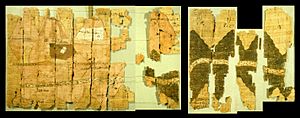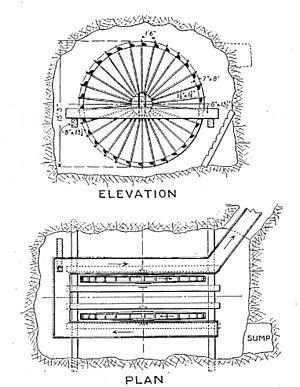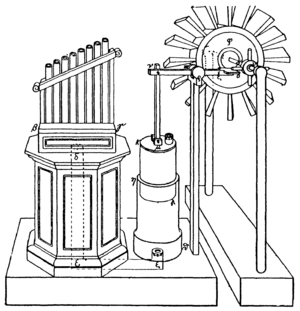Ancient technology facts for kids
Ancient technology refers to the amazing inventions and engineering skills developed by early civilizations. These discoveries changed how people lived and governed their societies. This article explores the cool inventions and engineering feats from ancient times. This period ended before the Middle Ages, around 476 AD. If you want to learn about technology from the Middle Ages, check out Medieval technology and Inventions in medieval Islam.
Contents
Amazing Ancient Inventions
African Innovations
Technology in Africa has a very long history. It goes back to the first evidence of tool use by early humans. These tools were found in the parts of Africa where humans are believed to have first evolved.
Africa saw some of the earliest ironworking technology. This happened in the Aïr Mountains region of what is now Niger. Also, some of the world's oldest monuments were built in Africa. These include pyramids and towers in Egypt, Nubia, and North Africa.
In Nubia and ancient Kush, people used glazed quartzite and built with brick more than in Egypt. Parts of the East African Swahili Coast even created the world's oldest carbon steel. They used very hot blast furnaces, made by the Haya people of Tanzania.
Mesopotamian Marvels
The people of Mesopotamia were among the first to use Bronze Age technology. They started with copper, bronze, and gold. Later, they began to use iron. Their palaces were decorated with lots of these expensive metals. Copper, bronze, and iron were also used for armor and weapons. These weapons included swords, daggers, spears, and maces.
Perhaps the most important invention by the Mesopotamians was writing. The Sumerians invented it. With writing came the first recorded laws, called the Code of Hammurabi. They also wrote the first major story, the Epic of Gilgamesh.
Mesopotamians invented several simple machines. They are credited with inventing the wheel. The wheel and axle first appeared with the potter's wheel. This was invented in Mesopotamia (modern Iraq) around 5000 BC. This led to the invention of the wheeled vehicle around 4000 BC. Pictures of wheeled wagons were found on clay tablet pictographs in Uruk. These date back to 3700–3500 BCE.
The lever was used in the shadoof. This device lifted water and was the first crane machine. It appeared in Mesopotamia around 3000 BC. The earliest proof of pulleys also dates back to Mesopotamia, around 2000 BC.
The screw was the last simple machine to be invented. It first appeared in Mesopotamia during the Neo-Assyrian period (911-609 BC). Some historians believe the first pump was the screw pump. It was used by Sennacherib, King of Assyria, for water systems in the Hanging Gardens of Babylon and Nineveh in the 7th century BCE.
The Mesopotamians used a number system based on 60. This is why we still have 60 seconds in a minute and 60 minutes in an hour. They also divided a circle into 360 degrees. They knew a lot about math, including addition, subtraction, multiplication, and division. They could even solve complex equations and use fractions. This math was important for keeping records and building large structures. They had ways to figure out the size and area of shapes like rectangles, circles, and triangles. Some evidence suggests they knew the Pythagorean Theorem long before Pythagoras. They might have even discovered the number for pi.
Babylonian astronomy allowed them to track the stars, planets, and Moon. They used advanced math to predict planet movements. By studying the Moon's phases, they created the first calendar. It had 12 lunar months and influenced the Jewish and Greek calendars.
Babylonian medicine used logic and recorded patient histories. They could diagnose and treat illnesses with creams and pills. They used both magical and physical treatments, seeing both as helpful.
The Mesopotamians made many technological discoveries. They were the first to use the potter's wheel for better pottery. They used irrigation to water their crops. They used bronze (and later iron) to make strong tools and weapons. They also used looms to weave cloth from wool. The Jerwan Aqueduct (around 688 BC) was made with stone arches and waterproof concrete.
Egyptian Engineering
The Egyptians invented and used many simple machines. For example, they used the ramp to help with building. They were among the first to get gold by mining on a large scale. They used a method called fire-setting. The first real map, the Turin papyrus, shows a plan of one of these mines in Nubia.
The Egyptians are famous for building pyramids centuries ago, without modern tools. Historians and archaeologists have found that the Egyptian pyramids were built using three simple machines. These were the inclined plane, the wedge, and the lever. These machines helped the ancient Egyptians move millions of limestone blocks. Each block weighed about 3.5 tons (7,000 lbs.). They used them to create huge structures like the Great Pyramid of Giza, which is 481 feet (146.7 meters) high.
Egyptian paper, made from papyrus, and pottery were made in large amounts. They were sold all over the Mediterranean. The wheel arrived later when invaders brought the chariot. Egyptians also developed sea technology, including ships and lighthouses. Early Egyptian buildings used bricks made of clay, sand, silt, and other minerals. These buildings were important for controlling floods and for irrigation along the Nile delta.
The screw pump is the oldest type of pump that moves a set amount of liquid with each turn. The first records of a screw pump, also called a water screw or Archimedes' screw, are from Ancient Egypt before 300 BC. The Egyptian screw lifted water from the Nile. It had tubes wrapped around a cylinder. As the whole thing turned, water was lifted up the spiral tube to a higher level. A later design had a spiral groove cut into a solid wooden cylinder. This cylinder was then covered by boards or metal sheets. The screw pump later spread from Egypt to Greece.
Indian Innovations
The history of science and technology in the Indian subcontinent goes back to the earliest civilizations. The Indus Valley civilization shows evidence of advanced mathematics, hydrography (water mapping), metrology (measurement), metallurgy (metal work), astronomy, medicine, surgery, civil engineering, and sewage systems.
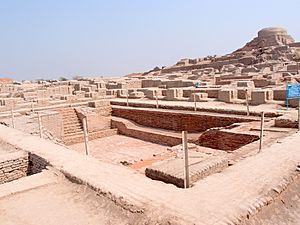
The Indus Valley Civilization, located in a rich area (modern Pakistan and northwestern India), is known for its early city planning. They had advanced sanitation technologies and plumbing. Cities in the Indus Valley have some of the first examples of closed gutters, public baths, and shared granaries.
The Takshashila University was an important learning center in the ancient world. Scholars from all over Asia studied there. Many Greek, Persian, and Chinese students learned from great scholars like Kautilya, Panini, Jivaka, and Vishnu Sharma.
The ancient Indian system of medicine, Ayurveda, was a big step forward. It mainly uses herbs as medicines. Its roots can be traced back to the Atharvaveda. The Sushruta Samhita (400 BC) by Sushruta describes how to do cataract surgery, plastic surgery, and more.
Ancient India was also skilled in seafaring technology. A panel found at Mohenjo-daro shows a sailing boat. Ship building is clearly described in the Yukti Kalpa Taru, an old Indian text on shipbuilding.
Indian construction and architecture, called 'Vaastu Shastra', shows a deep understanding of materials, water systems, and sanitation. Ancient Indian culture was also a leader in using vegetable dyes. They grew plants like indigo and cinnabar for dyes. Many dyes were used in art and sculpture. Their use of perfumes shows they knew about chemistry, especially how to distill and purify things.
Chinese Discoveries
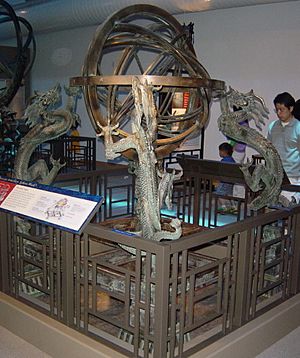
The history of science and technology in China shows big steps forward in science, technology, math, and astronomy. The first recorded sightings of comets, solar eclipses, and supernovae were made in China. Traditional Chinese medicine, acupuncture, and herbal medicine were also practiced. The Four Great Inventions of China are the compass, gunpowder, papermaking, and printing. These were some of the most important technological advances, only known in Europe much later.
According to researcher Joseph Needham, the Chinese made many first discoveries. Major Chinese inventions include early earthquake detectors, matches, paper, the double-action piston pump, cast iron, the iron plough, the multi-tube seed drill, the suspension bridge, natural gas as fuel, the magnetic compass, the raised-relief map, the propeller, the crossbow, the south-pointing chariot, and gunpowder. Other Chinese inventions from the Medieval period include block printing and movable type, glowing paint, and the spinning wheel.
The solid-fuel rocket was invented in China around 1150 AD. This was almost 200 years after black powder (the rocket's fuel) was invented. When Ferdinand Magellan's ships reached Brunei in 1521, they found a rich city. It had been protected by Chinese engineers and a breakwater. A crew member, Antonio Pigafetta, noted that Brunei's technology was as good as Western technology at the time. Brunei also had more cannons than Magellan's ships. Chinese merchants had sold them spectacles and porcelain, which were rare in Europe.
Persian Innovations
The Qanat, a water system for irrigation, started in Iran before the Achaemenid period of Persia. The oldest and largest known qanat is in the Iranian city of Gonabad. After 2,700 years, it still provides water to nearly 40,000 people.
The first proof of water wheels and watermills dates back to the ancient Near East around 400 BC. Specifically, they were used in the Persian Empire before 350 BCE. This was in Mesopotamia (Iraq) and Persia (Iran). This early use of water power was the first human-made power source that didn't rely on muscle (besides the sail).
In the 7th century AD, Persians in Afghanistan developed the first practical windmills.
Mesoamerican and Andean Achievements
The ancient civilizations of the Americas did not use wheeled transport. This was because they lacked suitable animals to pull carts. Also, their lands were often too mountainous or swampy for wheels. However, they still created advanced engineering. This included aqueducts (above and underground), earthquake-proof stone buildings, artificial lakes, dams, and complex terracing for farming.
Gold-working began early in Peru (2000 BCE). Later, they used copper, tin, lead, and bronze. Even though metalworking didn't reach Mesoamerica until the Middle Ages, it was used there and in the Andes for complex metal mixes and gilding (applying thin layers of gold). Native Americans deeply understood the uses of natural substances. Many of the world's early medicines and edible crops came from these civilizations. So did important glues, paints, fibers, plasters, and other useful items. Perhaps the most famous Mesoamerican invention was rubber. It was used to make rubber bands, balls, syringes, 'raincoats,' boots, and waterproof coverings for containers.
Hellenistic Mediterranean Discoveries
The Hellenistic period of Mediterranean history began in the 4th century BC. This was after Alexander's conquests. It led to a new Hellenistic civilization. This civilization mixed Greek and Near-East cultures in the Eastern Mediterranean. This included the Balkans, Levant, and Egypt. Ptolemaic Egypt was a center for learning. Greek was the main language. Scholars and engineers from Greece, Egypt, Jewish, Persia, and Phoenicia wrote in Greek.
Hellenistic technology made big progress from the 4th century BC, continuing into the Roman period. Some inventions credited to the ancient Greeks include bronze casting methods, the water organ (hydraulis), and the torsion siege engine. Many of these inventions happened later in the Hellenistic period. They were often created to improve weapons and war tactics.
Hellenistic engineers in the Eastern Mediterranean invented and improved many technologies. Archimedes invented several machines. These engineers often combined science with new technology. Inventions by Hellenistic engineers include the ballistae (large crossbows), the piston pump, and early analog computers like the Antikythera mechanism. Hellenistic architects built domes. They were also the first to study the Golden ratio and how it relates to geometry and architecture.
Other Hellenistic inventions include torsion catapults, pneumatic catapults, crossbows, rutways (grooves for carts), organs, the keyboard, differential gears, showers, dry docks, diving bells, odometers (distance measurers), and astrolabes. In architecture, Hellenistic engineers built huge lighthouses like the Pharos. They also designed central heating systems. The Tunnel of Eupalinos is the earliest tunnel dug from both ends using a scientific plan.
Automata, like automatic doors and other clever devices, were built by Hellenistic engineers such as Ctesibius and Philo of Byzantium. Greek technology writings were carefully studied by later Byzantine, Arabic, and Latin scholars. These writings provided some of the foundations for future technological advances in those civilizations.
Roman Empire Achievements
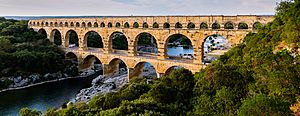
The Roman Empire grew from Italia to cover the entire Mediterranean region. This happened between the 1st century BC and 1st century AD. Its most advanced and richest areas outside of Italia were the Eastern Roman provinces. These included the Balkans, Asia Minor, Egypt, and the Levant. Roman Egypt was especially wealthy.
Roman technology supported Roman civilization. It helped the Roman economy and military grow for almost a thousand years. The Roman Empire had very advanced technology for its time. Some Roman technology in Europe may have been lost during the difficult times of Late Antiquity and the Early Middle Ages. Roman achievements in civil engineering, building materials, transport, and inventions like the mechanical reaper were not matched until the 19th century.
Romans developed advanced farming methods. They improved existing iron working technology. They created laws that allowed people to own property. They advanced stonemasonry technology. They built amazing roads (only surpassed in the 19th century). They also excelled in military engineering and civil engineering. They improved spinning and weaving. They created several machines, like the Gallic reaper, which boosted productivity in many parts of the Roman economy.
They also used water power on a large scale by building aqueducts. They used water not just for drinking, but also for irrigation, powering water mills, and in mining. They used drainage wheels a lot in deep underground mines. One such device was the reverse overshot water-wheel. They were the first to use hydraulic mining methods to find metal ores. They also extracted these ores using a method called hushing.
Roman engineers built triumphal arches, amphitheatres, aqueducts, public baths, true arch bridges, harbors, dams, vaults, and domes. These were built on a very large scale across their Empire. Famous Roman inventions include the book (Codex), glass blowing, and concrete. Because Rome was on a volcanic peninsula, its sand had special grains. This made the concrete the Romans made very strong. Some of their buildings have lasted 2000 years, to this day. Roman society also adopted the design of door locks with tumblers and springs from Greece. These mechanisms were very complex for their time.
Roman civilization was very urbanized for ancient times. Many cities in the Roman Empire had over 100,000 people. Rome, the capital, was the largest city of antiquity. Roman city life included multi-story apartment buildings called insulae, paved streets, public flush toilets, glass windows, and floor and wall heating. The Romans understood hydraulics. They built fountains and waterworks, especially aqueducts, which were a symbol of their civilization. They used water power by building water mills, sometimes in a series. Examples are found at Barbegal in southern France and possibly on the Janiculum in Rome. Some Roman baths still exist today. The Romans developed many technologies that seemed to be lost in the Middle Ages. They were only fully reinvented in the 19th and 20th centuries. They also left writings describing their achievements, especially Pliny the Elder, Frontinus, and Vitruvius.
Other lesser-known Roman inventions include cement, boat mills, arch dams, and possibly tide mills. In Roman Egypt, Heron of Alexandria invented the aeolipile. This was a basic steam-power device. He showed knowledge of mechanical and pneumatic systems. He was also the first to experiment with a wind-power mechanical device, a windwheel. He also described a vending machine. However, his inventions were mostly toys, not practical machines.
See also
 In Spanish: Tecnología antigua para niños
In Spanish: Tecnología antigua para niños


